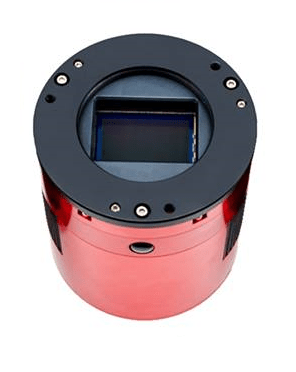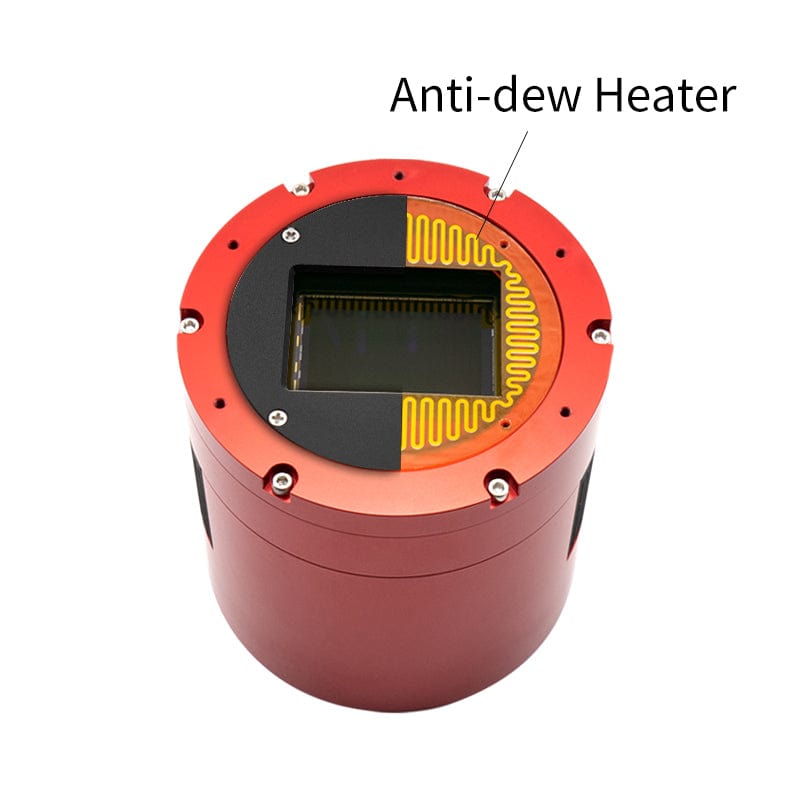Review: My First Impression On ZWO ASI2600MC Pro – Maicon Germiniani
The new ASI2600MC Pro uses Sony's latest back-illuminated IMX571 APS-C format native 16-bit ADC sensor. It has an ultra-high 14 stops dynamic range, ultra-low 1.0e readout noise and an innovative breakthrough resulting in zero amp glow. It is a camera born from the drive and excitement of astrophotography lovers.
Note: ZWO Cooled cameras require a 12V power source for the TEC cooler and USB hub power. If you don't have one, please add it through the options on the right side of the product display.
Important: ASI6200/2600/2400 cameras require 1A current from the USB port. If your PC can not provide enough current, please use an external 12V power supply to power the camera. A power shortfall will manifest with the camera disconnecting from the imaging software during capture of frames.
Important: For the following imaging camera models, please use a separate power supply rather than the power hub the ASIAIR Pro as the hub cannot provide enough amperage to power the camera's TEC coolers: ASI6200, ASI2600, ASI2400, ASI533, ASI071MC
Amazing Craftsmanship, Lightweight Body, Solid Image Quality
ZWO has been working hard to reduce the weight of the camera while improving the imaging performance. With this new camera, ZWO is able to reduce the ASI2600 weight to 0.7KG.
APS-C Format
The ASI2600MC Pro uses the APS-C format. The sensor length and width is 23.5mm x 15.7mm and the diagonal length is 28.3mm. This is a 26MP camera with a small pixel size of 3.76um that can accommodate a large well depth of 50ke.
Native 16-bit ADC
ASI2600MC Pro is ZWO's first batch of CMOS astronomy cameras with a 16-bit ADC. This 16-bit ADC is not a CCD 16-bit ADC, it can really achieve a dynamic range output of 14 stops. This significantly improves the image sharpness and contrast, and the color changes are smoother and more natural.
IMX571 Backlit Sensor
Sony's back-illuminated CMOS image sensor improves sensitivity and noise reduction – key factors to enhancing image quality, while radically realigning their fundamental pixel structure from front-illumination to back-illumination. It has retained the advantages of CMOS image sensors such as low power consumption and high-speed operation.
With a conventional front-illumination structure, the metal wiring and transistors on the surface of the silicon substrate that form the sensor's light-sensitive area (photo-diode) impede photon gathering carried out by the on-chip lens. A back-illuminated structure minimizes the degradation of sensitivity to optical angle response, while also increasing the amount of light that enters each pixel due to the lack of obstacles such as metal wiring and transistors that have been moved to the reverse of the silicon substrate.
Sony has newly developed a unique photo-diode structure and on-chip lens optimized for back-illuminated structures that achieves a higher sensitivity and a lower random noise without light by reducing noise, dark current and defect pixels compared to the conventional front-illuminated structure.
Camera Performance
The ASI2600MC Pro has excellent performance, with a dynamic range of up to 14stops. When the gain value is 100, the magical HCG high gain mode is turned on. This reduces readout noise, and the dynamic range is basically unchanged. It is recommended to set the gain to 0 or 100 for deep space images.
Zero Amp Glow
Traditional CMOS sensors produce a weak infrared light source during operation quite often seen in the corner of uncalibrated images as the tell tale signs of ‘amp glow'. As the ASI2600MC Pro uses zero amp glow circuitry, you won't have to worry about amp glow even when using high gain, long exposure imaging.
With amp glow – exposure 300 second exposure
ASI2600 frame with no amp glow – Exposure 300 seconds
Anti-Dew
ASI2600MC Pro comes with a polyimide heater, which is completely contained within the body of the camera. It uses 5W of power and can be software controlled.
QE
ZWO calculates the QE peak value of the ASI2600MC Pro is above 80%.
Two-Stage TEC Cooling, Ultra-Low Dark Current
Like the ASI6200, the ASI2600MC Pro also uses two stage TEC cooling and can lower the CMOS sensor temperature to more that 35°C below ambient temperature, which can greatly reduce dark current generation and sensor noise even with extended exposure times.
The unique dark current suppression technology can even further reduce dark current noise.
At 0°C, the dark current noise is only 0.0024e/s/pix, which means a 300s exposure will only produce a virtually invisible 0.7e dark current noise.
Note:You will need to use an external 12V power supply to power the camera cooler
DDR3 Memory Buffer
The ASI2600MC Pro is equipped with a USB 3.0 transmission interface and a built-in 256MB DDR3 cache to ensure stable and secure data transmission. For long exposures it effectively avoids frame dropping and greatly reduces the glow effects caused by slow reading speed.
Mechanical Diagram
What's in the box?
Note:Cooled cameras require a 12v power adapter, If you don't have one, please purchase one from us.
The Best Solution for 55mm Back Focus
Read more: https://astronomy-imaging-camera.com/tutorials/best-back-focus-length-solutions-55mm.html
Connection Diagram
- Nikon-T2 adapter
- EOS-T2 adapter
- 2" filter (optional)
- Nikon lens
- Canon lens
Drivers and Software
ZWO's website has newest camera drivers and many DSO and Planetary capture software. Please make sure the newest driver and software has been installed before you start shooting:


















